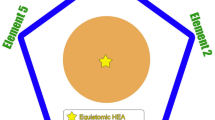Abstract
Configurational entropy is an important indicator of the formability of single solid solutions in multi-principal element alloys, typically estimated by using nominal compositions. However, nearly half of reported alloys consist of multiple phases rather than a single solid solution, leading to the redistribution of components among the constituent phases. In the present work, we evaluated the configurational entropy of constituent phases and the phase fraction-weighted configurational entropy in dual-phase γ/γ′ multi-principal element alloys within the Al–Cu–Fe–Ni–Ti quinary system. Two alloys, with the highest configurational entropy in either γ or γ′ phase, respectively, were selected by employing the high-throughput CALPHAD method and fabricated. It was found that the configurational entropies of constituent γ and γ′ phases, as well as the phase fraction-weighted value being lower than that of the nominal composition. The thermodynamic constraint of phase equilibria determines the elemental partitioning of the components in the constituent phases for multi-phase high-entropy alloys.








Similar content being viewed by others
Data Availability
Data will be made available on request.
References
J.W. Yeh, S.K. Chen, S.J. Lin, J.Y. Gan, T.S. Chin, T.T. Shun, C.H. Tsau, S.Y. Chang, Adv. Eng. Mater. 6, 299–303 (2004). https://doi.org/10.1002/adem.200300567
B. Cantor, I. Chang, P. Knight, A. Vincent, Mater. Sci. Eng. A 375, 213–218 (2004). https://doi.org/10.1016/j.msea.2003.10.257
O. Senkov, J. Miller, D. Miracle, C. Woodward, Nat. Commun. 6, 6529 (2015). https://doi.org/10.1038/ncomms7529
M.-H. Tsai, J.-W. Yeh, Mater. Res. Lett. 2, 107–123 (2014). https://doi.org/10.1080/21663831.2014.912690
D.B. Miracle, O.N. Senkov, Acta Mater. 122, 448–511 (2017). https://doi.org/10.1016/j.actamat.2016.08.081
Y. Jien-Wei, Ann. Chim. Sci. Mater. 31, 633–648 (2006). https://doi.org/10.3166/acsm.31.633-648
X. Yang, Y. Zhang, Mater. Chem. Phys. 132, 233–238 (2012). https://doi.org/10.1016/j.matchemphys.2011.11.021
Y. Lu, Y. Dong, S. Guo, L. Jiang, H. Kang, T. Wang, B. Wen, Z. Wang, J. Jie, Z. Cao, Sci. Rep. 4, 1–5 (2014). https://doi.org/10.1038/srep06200
T.-K. Tsao, A.-C. Yeh, C.-M. Kuo, K. Kakehi, H. Murakami, J.-W. Yeh, S.-R. Jian, Sci. Rep. 7, 12658 (2017). https://doi.org/10.1038/s41598-017-13026-7
Y.-T. Chen, Y.-J. Chang, H. Murakami, S. Gorsse, A.-C. Yeh, Scripta Mater. 187, 177–182 (2020). https://doi.org/10.1016/j.scriptamat.2020.06.002
O.N. Senkov, D. Isheim, D.N. Seidman, A.L. Pilchak, Entropy 18, 102 (2016). https://doi.org/10.3390/e18030102
D.B. Miracle, M.-H. Tsai, O.N. Senkov, V. Soni, R. Banerjee, Scripta Mater. 187, 445–452 (2020). https://doi.org/10.1016/j.scriptamat.2020.06.048
S.-Y. Yen, H. Murakami, S.-K. Lin, J. Alloys Compd. 952, 170027 (2023). https://doi.org/10.1016/j.jallcom.2023.170027
S. Gorsse, M. Nguyen, O.N. Senkov, D.B. Miracle, Data Brief 21, 2664–2678 (2018). https://doi.org/10.1016/j.dib.2018.11.111
N. Saunders, A.P. Miodownik, CALPHAD (Calculation of Phase Diagrams): A Comprehensive Guide (Elsevier, Amsterdam, 1998)
B. Sundman, H. Lukas, S. Fries, Computational Thermodynamics: The Calphad Method (Cambridge University Press, Cambridge, 2007)
S. Yang, J. Lu, F. **ng, L. Zhang, Y. Zhong, Acta Mater. 192, 11–19 (2020). https://doi.org/10.1016/j.actamat.2020.03.039
Y.-C. Liu, S.-Y. Yen, S.-H. Chu, S.-K. Lin, M.-H. Tsai, Mater. Today Commun. 26, 102096 (2021). https://doi.org/10.1016/j.mtcomm.2021.102096
W. Cao, S.L. Chen, F. Zhang, K. Wu, Y. Yang, Y. Chang, R. Schmid-Fetzer, W. Oates, Calphad 33, 328–342 (2009)
E. Chauvet, P. Kontis, E.A. Jägle, B. Gault, D. Raabe, C. Tassin, J.-J. Blandin, R. Dendievel, B. Vayre, S. Abed, Acta Mater. 142, 82–94 (2018). https://doi.org/10.1016/j.actamat.2017.09.047
M. Wenderoth, R. Völkl, T. Yokokawa, Y. Yamabe-Mitarai, H. Harada, Scripta Mater. 54, 275–279 (2006). https://doi.org/10.1016/j.scriptamat.2005.09.017
Y. Ro, Y. Koizumi, H. Harada, Mater. Sci. Eng. A 223, 59–63 (1997). https://doi.org/10.1016/S0921-5093(96)10504-9
T. Murakumo, T. Kobayashi, Y. Koizumi, H. Harada, Acta Mater. 52, 3737–3744 (2004). https://doi.org/10.1016/j.actamat.2004.04.028
D. Pope, S.S. Ezz, Int. Metals Rev. 29, 136–167 (1984). https://doi.org/10.1179/imtr.1984.29.1.136
M. Hillert, Phase Equilibria, Phase Diagrams and Phase Transformations: Their Thermodynamic basis (Cambridge University Press, Cambridge, 2007)
R.C. Reed, The Superalloys: Fundamentals and Applications (Cambridge University Press, Cambridge, 2008)
Acknowledgements
The authors gratefully acknowledge the financial supports from the National Science and Technology Council (NSTC) in Taiwan (Grant Nos. 112-2628-E-006-019, 112-2622-8-006-020, and 112-2923-E-006-004). This work was also partially supported by the Hierarchical Green-Energy Materials (Hi-GEM) Research Center, from The Featured Areas Research Center Program within the framework of the Higher Education Sprout Project by the Ministry of Education (MOE) in Taiwan. The authors gratefully acknowledge to Ms. Mei-Lan Liang and Ms. Shih-Wen Tseng from Core Facility Center, National Cheng Kung University for DB-FIB and Cs-corrected TEM/STEM analyses.
Funding
Funding was provided by National Science and Technology Council (Grant Nos. 112-2628-E-006-019, 112-2622-8-006-020, 112-2923-E-006-004).
Author information
Authors and Affiliations
Contributions
Shao-yu Yen: methodology, software, validation, and writing—original draft. Hao-che Wang: software and investigation. Shih-kang Lin: conceptualization, resources, writing—review & editing, funding acquisition, and supervision.
Corresponding author
Ethics declarations
Competing Interests
On behalf of all authors, the corresponding author states that there is no conflict of interest.
Rights and permissions
Springer Nature or its licensor (e.g. a society or other partner) holds exclusive rights to this article under a publishing agreement with the author(s) or other rightsholder(s); author self-archiving of the accepted manuscript version of this article is solely governed by the terms of such publishing agreement and applicable law.
About this article
Cite this article
Yen, Sy., Wang, Hc. & Lin, Sk. On the Phase Configurational Entropy of Dual-Phase γ/γ′ Multi-principal Element Alloys: A Case Study on the Al–Cu–Fe–Ni–Ti System. High Entropy Alloys & Materials (2024). https://doi.org/10.1007/s44210-024-00037-z
Received:
Accepted:
Published:
DOI: https://doi.org/10.1007/s44210-024-00037-z




